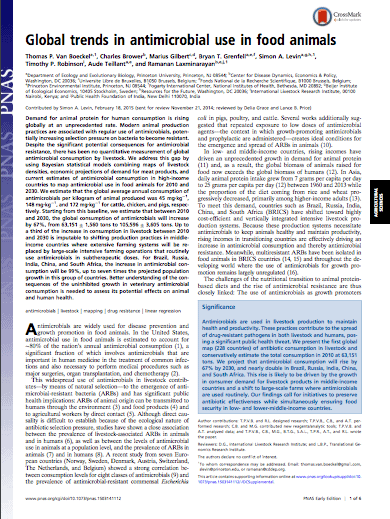May 05, 2015

The Question
What are current consumption levels for antimicrobial use in food animals worldwide? What trends can be expected in consumption over the next 15 years?
What we found
We project a 67% increase in the global consumption of antimicrobials between 2010 and 2030. Up to a third of the increase in consumption in livestock between 2010 and 2030 can be attributed to to shifting production practices in middle-income countries where extensive farming systems will be replaced by largescale intensive farming operations that routinely use antimicrobials in sub-therapeutic doses. We estimate that the global average annual consumption of antimicrobials per kilogram of animal produced was the highest for pigs at 172 mg·kg−1 pigs. For Brazil, Russia, India, China, and South Africa, the increase in total livestock antimicrobial consumption will be 99%, up to seven times the projected population growth in this group of countries.
Why it matters
Without reliable evidence to estimate global antimicrobial consumption in livestock, the links between antimicrobial consumption and resistance patterns are poorly quantified, and efforts and policies to optimize antibiotic use in animals are poorly targeted.
This widespread use of antimicrobials in livestock contributes––by means of natural selection––to the emergence of antimicrobial-resistant bacteria (ARB) and has significant public health implications. ARB of animal origin can be transmitted to humans through the environment and food products and to agricultural workers by direct contact. The use of antimicrobials as growth promoters and therapeutics to support the growing demand for meat is placing ever greater selection pressure for resistant strains of bacteria to evolve. Whereas trends in antibiotic consumption in humans are now being tracked in most high-income and some middle-income countries through databases on antibiotic sales, antimicrobial consumption in livestock has received comparatively little attention. Expert opinion suggests that global consumption of antimicrobials in animals is twice that of humans. Better understanding of the consequences of the uninhibited growth in veterinary antimicrobial consumption is needed to assess its potential effects on animal and human health.

